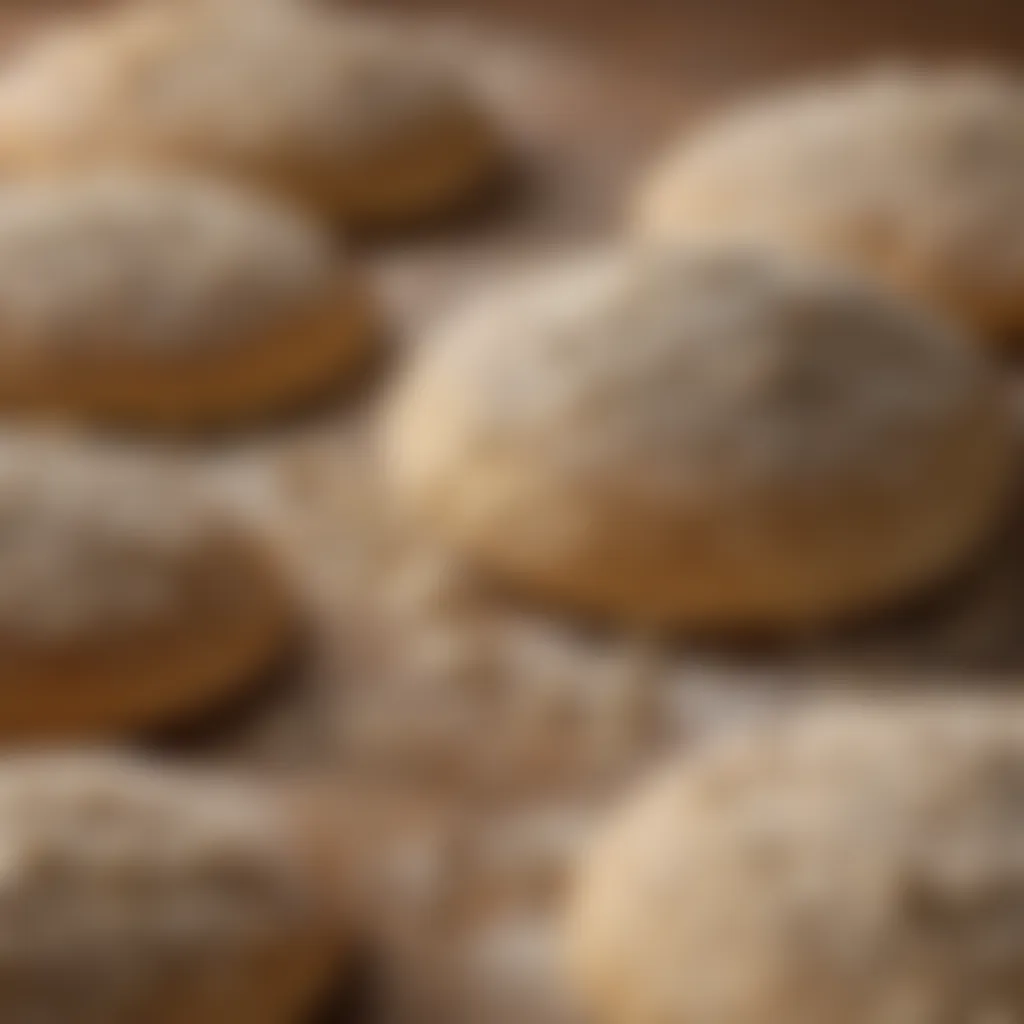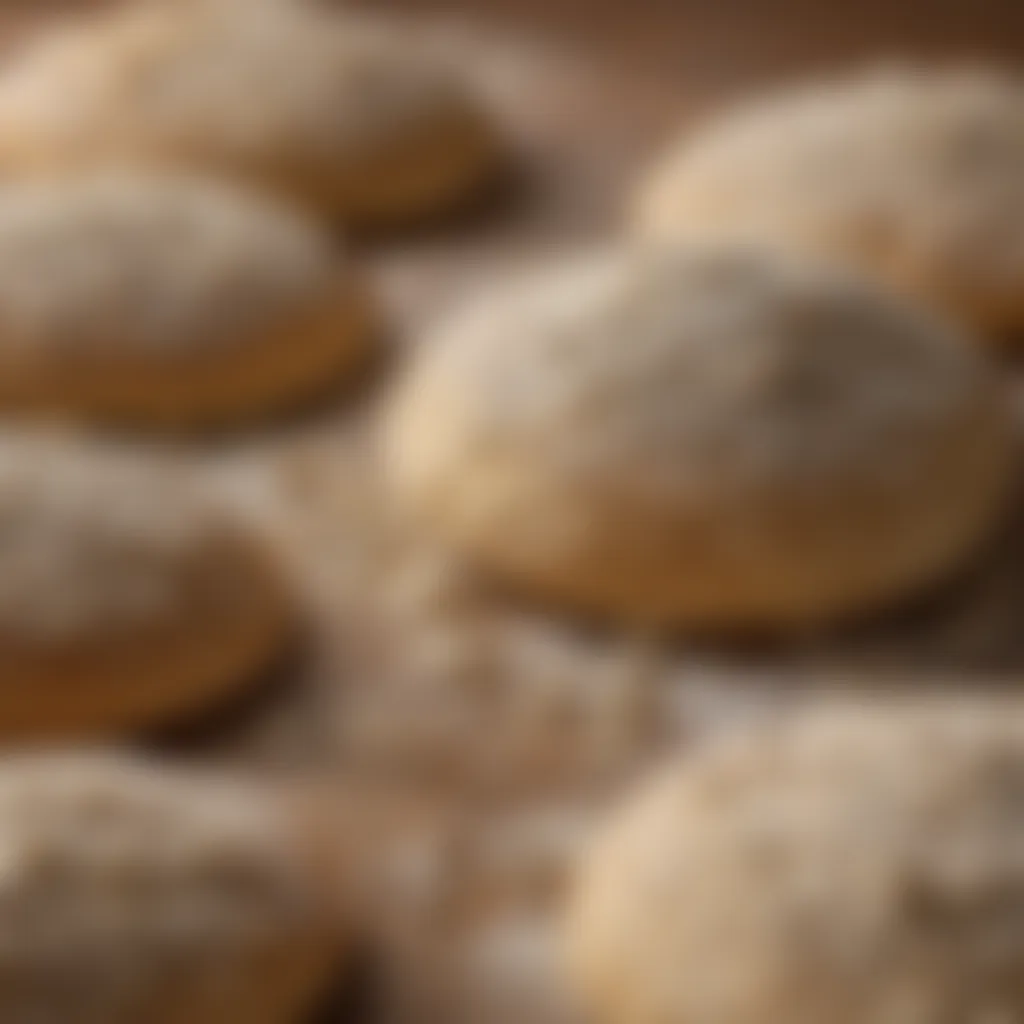Mastering Gourmet Pizza: Techniques for Culinary Excellence


Ingredients:
Crafting the perfect gourmet pizza starts with selecting the right ingredients. Below is a detailed list of everything you’ll need to get started:
- Dough: 2 cups of all-purpose flour (plus more for dusting), 1/2 teaspoon of salt, 1 teaspoon of sugar, 1 packet (2 1/4 teaspoons) of active dry yeast, and 3/4 cup of warm water (about 110°F).
- Sauce: 1 cup of crushed tomatoes (preferably San Marzano), 1 tablespoon of olive oil, 2 cloves of garlic (minced), 1 teaspoon of dried oregano, and a pinch of salt.
- Toppings: 1 1/2 cups of shredded mozzarella cheese, optional ingredients like fresh basil leaves, sliced pepperoni, bell peppers, mushrooms, olives, and any gourmet additions like prosciutto or arugula.
- Finishing Touches: 2 tablespoons of grated Parmesan cheese, a drizzle of balsamic glaze, and a sprinkle of red pepper flakes for an extra kick.
Preparation Steps:
Getting the dough ready is crucial. Here’s a step-by-step guide:
- Activate Yeast: In a small bowl, mix warm water with sugar and yeast. Let it sit for about 5 minutes until it froths. This shows that the yeast is active.
- Mix Dry Ingredients: In a larger bowl, combine flour and salt. Create a well in the center and pour in the yeast mixture.
- Combine: Gradually mix in the flour until a dough starts forming.
- Knead the Dough: Transfer the dough to a lightly floured surface. Knead for about 8–10 minutes until smooth and elastic.
- First Rise: Place the dough in a greased bowl, cover it with a damp cloth, and let it rise in a warm place for 1–2 hours until it doubles in size.
Technical Aspects:
To achieve excellent results, pay attention to some technical details:
- Temperature Settings: Preheat your oven to 475°F (245°C) at least 30 minutes before baking. An oven thermometer can help ensure accuracy.
- Dough Resting Time: Allow the dough to reach room temperature for about 10–15 minutes before stretching it into shape.
- Cooking Time: A cooking time of about 10–15 minutes typically results in a well-cooked base and bubbly cheese.
Cooking Process:
Now that you’ve prepared everything, let’s dive into the actual cooking method:
- Shape the Pizza: On a floured surface, stretch the dough into a 12-inch round. Create a small border for the crust.
- Spread the Sauce: Using a spoon, evenly spread the sauce over the dough, leaving the edges clear for the crust.
- Add Toppings: Sprinkle mozzarella cheese first, then layer on your choices of toppings. Less is more here—don’t overcrowd the pizza.
- Bake: Carefully slide the pizza onto a preheated pizza stone or baking sheet. Bake for 10–15 minutes until the crust turns golden brown and crispy.
- Finish Up: Once out of the oven, sprinkle with Parmesan cheese. Add fresh basil or a drizzle of balsamic glaze for that gourmet touch.
Troubleshooting Tips:
Even when you're a seasoned cook, mistakes can happen. Here’s help for common issues:
- Dough Too Sticky: If your dough is sticking to the surface, add a little more flour while kneading, but keep it minimal to avoid drying out.
- Soggy Pizza: If your toppings yield too much moisture, try pre-cooking them slightly. Also, make sure to avoid excessive sauce.
- Burnt Crust: If the crust is overcooking, lower the oven temperature slightly and keep an eye on it. Better safe than sorry!
Baking gourmet pizza requires precision and care. Mastering these ingredients and techniques can transform a simple meal into a delightful feast.
The Foundation of Gourmet Pizza
When venturing into the world of gourmet pizza crafting, establishing a solid foundation is key. This section delves into the core components that shape your pizza experience. By understanding various pizza styles, selecting essential ingredients, and mastering dough-making techniques, you lay the groundwork for creating pizzas that are not just meals, but culinary masterpieces. These elements harmonize to produce delicious results that can impress family and friends alike.
Understanding Pizza Styles
The diversity in pizza styles is as vast as the cultures they originate from. From the thin, crisp crust of a Neapolitan pie to the thick, doughy base of Chicago deep-dish, knowing various styles gives you the flexibility to choose a method that resonates with your taste or occasions.
Each style boasts unique characteristics. Neapolitan pizza, with its soft center and burnt edges, exemplifies simplicity with just fresh tomatoes, mozzarella, basil, and olive oil. Conversely, New York-style pizza charms diners with its foldable, sturdy crust, topped with tomato sauce and a hearty helping of cheese. Understanding these differences informs your crafting approach, guiding your selections in crust thickness, toppings, and serving tradition.
Essential Ingredients for Gourmet Pizzas
The saying "you are what you eat" may be old, but it holds water, especially when it comes to pizza. The very ingredients you choose can elevate a simple dish into a gourmet experience. Selecting high-quality ingredients is not just a whim but a fundamental step in crafting gourmet pizzas.
- Flour: Look for high-protein flour, as it offers the necessary gluten development for a chewy crust. Brands like Caputo are widely praised among professionals.
- Tomato Sauce: Fresh crushed tomatoes with a hint of salt and basil make for an easy yet flavorful base.
- Cheese: Opt for fresh mozzarella, provolone, or other gourmet cheese, as it melts beautifully and provides the taste you'd expect from a high-end pizzeria.
Combining these with fresh, seasonal toppings can provide a taste explosion that is difficult to replicate with lower-quality alternatives.
The Art of Dough Making
Dough is the heart of every pizza. It's not merely a base, but an essential element that can make or break your pie. Mastering the art of dough making involves understanding several key aspects, including hydration levels, kneading techniques, and the fermentation process. Each plays a vital role in texture, flavor, and overall quality.
Hydration Levels Impact
Hydration levels in pizza dough refer to the ratio of water compared to flour. A higher hydration leads to a softer, airier crust, which is often sought after in gourmet pizzas. Generally, pizzaiolos recommend a hydration level of around 60% to 70% for traditional styles. While it can be a tad tricky to handle, it vastly enhances texture as it encourages the formation of steam during baking, leading to a beautifully puffed crust. Using a wetter dough also allows for a more robust flavor development as it ferments deeper.
Kneading Techniques
Kneading dough isn’t just about beating it into submission. It’s about developing gluten structure while being mindful of not overworking it. A traditional method involves folding and stretching rather than aggressive punching. This gentle kneading respects the dough, allowing it to develop elasticity without becoming tough. Employing techniques like the 'stretch and fold' method retains air pockets, resulting in a crust that is crispy yet light.


Fermentation Process
Fermentation is where the magic truly happens. This process allows the dough to rise and develop flavor. A slow fermentation—sometimes lasting over 24 hours—gives the yeast time to produce a more complex flavor profile that is undeniably gourmet. The uniqueness of fermentation lies in its ability to not only affect the taste of the crust but also its digestibility. The longer the fermentation, the less likely the dough will cause discomfort, as the yeast eats up some of the gluten.
"Quality pizza starts with quality dough—where flavor and texture dance in perfect harmony."
Crafting the Perfect Pizza Dough
When it comes to creating a memorable gourmet pizza, the cornerstone of your culinary masterpiece is undoubtedly the dough. It's more than just a foundation; it’s the very essence of what separates a good pizza from a great one. Perfecting the art of pizza dough is vital for those who wish to elevate their pizza-making skills. As you embark on this scrumptious journey, keep in mind that a well-crafted dough provides the textural contrast that enhances all the toppings you decide to layer on. This section will delve into several crucial aspects, including flour choices, yeast development, and the proper techniques for storing your dough.
Choosing the Right Flour
Flour selection might seem simple, but it can make all the difference between a chewy and a crusty pizza. The type of flour you use affects gluten development, which ultimately determines the dough's stretchability and texture.
Bread flour is often preferred for its higher protein content, which fosters strong gluten development. On the flip side, 00 flour—a finely milled flour originating from Italy—yields a softer crust, perfect for Neapolitan-style pizzas.
When selecting flour, consider the following:
- Protein Content: Aim for flour with a protein content of around 12-14% for a good balance of chewiness and crispness.
- Milling Type: Choose between finely milled and coarser flours depending on your desired crust texture.
- Source: Look for local and organic options, as they often provide deeper flavors.
"A pizza's dough has a heart as strong as the ingredients resting atop it. Choose wisely!"
The Role of Yeast and Development
Yeast is the magical ingredient that helps your dough rise and contribute to that light, airy texture we all crave. Understanding the role of yeast in dough development will allow you to take full advantage of its benefits.
There are generally two types of yeast used in pizza making: active dry yeast and instant yeast. Active dry yeast requires proofing—dissolving in warm water before use—while instant yeast can be mixed directly with flour, simplifying the process.
Here’s a brief look at how yeast impacts your dough:
- Fermentation: This process adds flavor to your dough. Longer fermentation times typically yield deeper flavors, so consider resting your dough in the fridge overnight.
- Rising: When properly activated, yeast produces carbon dioxide, causing your dough to rise. This is crucial for that fluffy edge.
- Flavor Development: Different fermentation times influence the complexity of the flavor. Longer is often better.
Tips for Proper Dough Storage
Once you've crafted your dough, proper storage becomes essential to maintaining its quality. Here are some guidelines:
- Cold Fermentation: Refrigerate your dough to slow down the fermentation process. This not only enhances flavor but also allows you to prepare it in advance.
- Air-Tight Sealing: Ensure you've stored your dough in an air-tight container to avoid drying out. Use plastic wrap or a tightly sealed bag.
- Portioning: If you're making multiple pizzas, consider dividing your dough into portions before storing. This allows for easy access and minimizes exposure to air when you're ready to cook.
By mastering the intricacies of crafting the perfect pizza dough, you set a solid groundwork for the splendid toppings and textures that will follow. Each step you take in this foundational phase builds towards a culinary delight unlike any other, making your gourmet pizza-making endeavors truly worthwhile.
Exploring Gourmet Toppings
Toppings are the soul of gourmet pizza, significantly enhancing its flavor and making each creation unique. Understanding how to use ingredients is vital to achieving that delightful burst of taste everyone craves. Each topping can either complement or overwhelm the flavors of the pizza, so one's choice must be deliberate. This section will provide insight into selecting and using toppings effectively, focusing on the benefits of freshness, the complexities of layering, and the role different types of cheese play in the overall pizza experience.
Fresh vs. Preserved Ingredients
When discussing toppings, the age-old debate of fresh versus preserved ingredients often comes to the fore. Fresh ingredients such as ripe tomatoes, fresh basil, and seasonal vegetables can elevate a pizza from ordinary to extraordinary. They breathe life into every bite. For example, using fresh tomatoes instead of canned ones offers a burst of sweetness and acidity that can change the entire profile of the dish.
On the other hand, preserved ingredients can also play a critical role. Items like sun-dried tomatoes or olives have concentrated flavors, providing depth and a punch that fresh products might lack. It's all about balancing these two types of ingredients effectively. Consider this: using a fresh mozzarella cheese alongside sun-dried tomatoes can create a delightful contrast that keeps your palate intrigued.
"The harmony between fresh and preserved toppings can make your gourmet pizza a culinary masterpiece."
Layering Techniques for Flavor Complexity
Layering is an art form unto itself. The key is to build flavors from the base toward the top, ensuring each ingredient has its time to shine. Start with a good spread of sauce, but control the amount so it doesn't drown other elements. For instance, sprinkling a bit of crushed red pepper in the sauce can infuse the entire pizza with a subtle heat.
As you move up the layers, consider the texture and flavor dynamics. Here's a simple guide:
- Base Layer: Choose a flavorful sauce that complements your overall theme. Think pesto on a white pizza or a hearty tomato sauce for a traditional feel.
- Middle Layer: Add protein-rich toppings like prosciutto or pepperoni, giving weight to the pizza. Spread them evenly to avoid clumps.
- Top Layer: Finish with fresh herbs and light ingredients, like arugula or microgreens, which can add an explosion of flavor and a hint of freshness right before serving.
This careful layering technique can lead to a well-balanced pizza that tantalizes taste buds at every bite.


The Influence of Cheese Varieties
Cheese is not just a topping; it's often the heart of gourmet pizzas. The variety of cheese available allows for limitless configurations. Say you opt for a gooey gorgonzola—its pungency adds a bold flavor, distinctly enriching your dish. If you go with burrata, its creamy texture can elevate even the simplest layer of heirloom tomatoes.
Some cheeses melt better than others. For example, mozzarella is famous for its stretchiness, while parmesan brings a nutty, hard texture that can provide an interesting contrast to softer toppings.
Experimenting with different cheese combinations can yield surprising outcomes. Here are a few suggestions:
- Classic Duo: Mozzarella and parmesan for a traditional yet flavorful mix.
- Bold Blend: Gorgonzola with mozzarella for an unforgettable flavor experience.
- Unique Choice: A mix of ricotta dollops on top of marinara can mimic a lasagna effect without overwhelming the palate.
Ultimately, the right choice of cheese can alter the trajectory of your pizza-making journey, making it essential to explore the variety of options available. Each variety not only tastes distinct but also contributes to the visual appeal of the pizza. Every bite can tell a story, one of textures and flavors that they will never forget.
Oven Types and Cooking Methods
Understanding the various types of ovens and their cooking methods is a fundamental aspect in the quest for mastering gourmet pizza crafting. Each oven type not only influences the texture and flavor of the pizza but also dictates the cooking process, from dough preparation all the way to the final presentation. The right oven can transform a good pizza into a remarkable one, making it imperative to consider the attributes of each type available.
Wood-Fired Ovens: An Overview
Wood-fired ovens stand as a hallmark of traditional pizza making, known for imparting unique flavors that are hard to replicate. These ovens use wood as a fuel source, reaching extremely high temperatures—often above 900°F (482°C). At such temperatures, pizzas cook rapidly, typically within 90 seconds. This swift cooking time is crucial as it creates a crispy crust while keeping the toppings fresh and vibrant.
Wood-fired ovens are typically dome-shaped which contributes to even heat distribution. The burning wood not only fires the oven but also adds a distinct smokiness to the crust, elevating the pizza experience. Users will need to consider the type of wood used, such as cherry, oak, or hickory, as each variety affects the flavor differently.
"Cooking with a wood-fired oven is about patience and practice. It’s not just a cooking method; it’s an art."
Electric Ovens versus Gas Ovens
When comparing electric and gas ovens for pizza making, both have their advantages and considerations.
Electric ovens are widely appreciated for their consistent heat distribution. They often come with settings that allow precise temperature control, which is critical for pizza recipes that demand high heat without fluctuations. Constructed with heating elements that provide a steady source of warmth, electric ovens can cook pizza evenly and are easy to operate. However, some may argue that they fall short on that 'charred' element that many gourmet pizzas boast.
Gas ovens, on the other hand, utilize gas burners that provide a more responsive heat. This can be beneficial for those looking to achieve a perfect balance between crispiness and chewiness. The flames offer a rustic touch and can better replicate the intense environment of a wood-fired oven, making gas a popular choice among professional chefs. Yet, one must ensure proper ventilation as gas ovens can produce fumes.
Ultimately, the choice between these two comes down to personal preference, available technology, and the specific outcomes desired.
Temperature Control and Cooking Time
The importance of temperature control and cooking time cannot be overstated in pizza crafting. Achieving the right balance ensures that the crust is neither overcooked nor underdone, while the toppings reach a stage of perfect doneness.
Each oven type has its quirks. Here’s a breakdown of considerations:
- Preheating: Always preheat your oven to the desired temperature before placing the pizza inside. This step ensures immediate contact with heat, contributing to an optimal crust.
- Thermometers: Invest in an oven thermometer for precision. Some built-in thermometers can be misleading.
- Pizza Stones: Using a pizza stone can help maintain high temperatures, absorb moisture, and encourage a crispy base—especially in electric and gas ovens.
- Cooking Times: A general guideline is that pizzas will cook in 10 to 15 minutes in a standard oven, depending on temperature and toppings. However, wood-fired ovens accelerate this time significantly.
Familiarity with your oven's behavior and learning through practice will ultimately enhance your results, leading to gourmet level pizzas right in your own kitchen.
Presentation and Serving Techniques
In the realm of gourmet pizza crafting, the importance of presentation and serving techniques cannot be overstated. The visual appeal of a dish can elevate the dining experience, instilling a sense of anticipation before the first bite. Well-crafted presentation transforms a simple meal into an extraordinary feast. With pizza, there are key elements that contribute to its overall presentation, including plating choices, garnishing, and temperature at which the dish is served.
Plating Essentials for Gourmet Pizzas
When it comes to plating pizza, the first impression can make or break the experience. The base of your pizza is crucial; consider using a wooden butchers block or a vibrant, textured plate to add character. A minimalist approach is often effective. Position slices neatly and with precision, leaving room for the eye to wander without feeling cluttered.
- Choose Colorful Plates: A white or neutral base can make the colors of your toppings pop.
- Use a Pizza Peel for Traditional Touch: This not only makes for an authentic presentation but also transports the pizza with style.
- Slice Strategically: Cut in even-sized pieces to maintain symmetry on the plate.
An engaging presentation encourages diners to appreciate the artistry behind each pizza, setting the stage for a memorable meal.
Enhancing Visual Appeal with Garnishes
Garnishing brings an additional layer of artistry to gourmet pizza. A sprinkle of fresh basil or a drizzle of balsamic glaze adds both color and contrast. Here are some techniques to consider:
- Fresh Herbs: Using fresh basil or oregano can add a splash of green.
- Drizzles: A gentle drizzle of infused oils or a balsamic reduction can create a striking finish.
- Textural Additions: Adding a few crunchy elements like toasted pine nuts can make the pizza more visually exciting and interesting to eat.


"The beauty of a dish lies not only in the flavors but in the way it's presented. A gourmet pizza should seduce the eyes before it delights the palate."
Serving Temperature Considerations
The temperature at which pizza is served plays a significant role in how flavors are perceived. Pizza is best enjoyed when it’s hot, bringing out the melting cheese and the aromas of baked toppings. Serve your pizza straight from the oven or keep it warm on a pizza stone. Here are a few tips:
- Check Internal Temperature: Ideally, pizza is best served at a temperature between 150°F and 160°F (65°C - 70°C).
- Heating the Plate: Pre-warm your serving plate in the oven, so the heat from the plate helps maintain pizza temperature during serving.
- Avoiding Overloading on Toppings: While it might be tempting to load up your pizza, excessive toppings can lead to a soggy crust, resulting in a less enjoyable eating experience.
Mastering these aspects of presenting and serving gourmet pizza enhances not only its appeal but contributes to an unforgettable dining experience. The balance between aesthetic formalities and practical temperature maintenance ensures that every bite is savored only at its best.
Common Pitfalls in Pizza Crafting
Crafting the perfect gourmet pizza is as much about avoiding mistakes as it is about implementing techniques. Understanding common pitfalls in pizza making not only saves time but elevates the outcome significantly. By shedding light on these missteps, aspiring chefs can navigate the culinary landscape with confidence, turning potential disasters into delectable successes.
Avoiding Overworked Dough
Dough is the lifeblood of pizza. However, many novice cooks find themselves caught in the trap of overworking it. When dough is kneaded excessively, gluten strands can develop too much, making the crust tough instead of light and airy. The goal here is to achieve a balance—enough gluten development to provide structure without sacrificing that desired softness.
An effective strategy to prevent overworked dough is the "stretch and fold" method, which promotes elasticity without aggressive kneading. Here’s a simple way to implement this:
- Mix your ingredients until they come together.
- Let the dough rest for about 20 minutes.
- Stretch one side of the dough, then fold it over itself, repeating this around the dough.
- Cover and let it rise, allowing the gluten to relax.
This approach preserves the dough's integrity, so your crust delivers that perfect bite—both tender and crisp.
Balancing Ingredients Effectively
Achieving harmony among ingredients is crucial in gourmet pizza crafting. An imbalance can lead to a lackluster pizza that fails to impress. When deciding what toppings to include, consider the "1:1 ratio rule"—equal parts of each ingredient can lead to a stable flavor profile.
For instance, if you’re using a rich cheese like mozzarella, complement it with a fresh, tangy sauce and vibrant vegetables—think bell peppers and fresh basil. Conversely, if you’re using robust toppings like pepperoni or spicy sausage, consider lighter accompaniments like mushrooms or arugula.
Remember, too much of a good thing can be bad. During the assembly phase:
- Layer thinly. Ensuring even coverage helps flavors meld without overwhelming,
- Taste as you go. A bite of each topping before it goes on the pie can reveal much about the final flavor profile,
By being mindful about ingredient ratios, you can craft pizzas that will please a variety of palates—no more skimping on toppings or overpowering flavors.
Managing Expectations in Cooking Times
Whether you’re pulling a pizza out of a traditional wood-fired oven or your trusty home oven, managing expectations around cooking times is essential. Many beginners think that longer cooking automatically equals better pizza, but this is a misconception that can lead to burnt crusts and dried out toppings.
Different ovens yield varied results. For example, wood-fired ovens can cook pizzas in under two minutes, while conventional ovens may take 10-15 minutes at a higher temperature. A good rule of thumb is to watch the pizza closely. If the crust is golden brown and the cheese is bubbling, you’re likely on the right track.
Additionally, understanding carryover cooking is vital. Once removed from the oven, the pizza continues to cook slightly. So, if it looks done at the 10-minute mark, consider pulling it out a shade earlier to avoid overcooking.
"Cooking is like a relationship; it's all about knowing when to pull away for the best results."
The Role of Experimentation
Experimentation is the lifeblood of any culinary endeavor, and gourmet pizza crafting is no exception. It underscores creativity, encourages exploration, and brings a comforting uncertainty that can yield delicious surprises. When you step away from the typical pepperoni and mozzarella routine, you open doors to flavors and textures that can elevate your pizza from ordinary to extraordinary. The beauty of pizza lies in its versatility; the crust can change based on the type of flour, the sauce can go beyond traditional tomato, and toppings can embrace global influences. This section highlights the vital aspects of experimentation in gourmet pizza crafting.
Incorporating Global Flavors
Incorporating flavors from around the world transforms your pizza into an adventure on a plate. Imagine a pizza topped with spicy harissa, roasted eggplant, and feta cheese inspired by North African cuisine. Or how about a sushi pizza with nori, wasabi mayo, and fresh raw fish? The fusion possibilities are endless.
Using ingredients from diverse cultures not only adds depth but also creates a conversation starter at the dinner table. This mixing of elements requires a boldness to stray from the familiar while ensuring that every ingredient complements the others. So, whether it's a drizzle of balsamic glaze over a classic margherita or adding sriracha to a cheesy base, the aim is to infuse each bite with exciting flavors that tell a story.
Adapting Recipes to Personal Preferences
Every cook has a palate that speaks to them. Experimentation isn’t just about combining unusual ingredients; it’s about personalizing each creation. A gourmet pizza should be a reflection of one’s taste. This might mean swapping out the cheese for a vegan alternative or using homemade pesto instead of store-bought. If someone can't handle heat, skip the hot chilis and try roasted garlic instead. Knowing your likes and dislikes is key.
It’s also beneficial to consider dietary restrictions. Crafting a gluten-free dough or finding alternatives for dairy can give everyone at the table a chance to enjoy the meal. These small changes can leave a big mark on how you perceive and enjoy your pizza. Remember, the goal is to have fun while experimenting; so don’t hesitate to try swapping ingredients based on what you have at hand.
Documenting Your Pizza Journey
Tracking your pizza-making experiments can be both insightful and entertaining. Keeping a pizza journal provides a way to reflect on what works and what doesn’t. Record your successes, but don't shy away from noting the mishaps too. Maybe you forgot to add salt to the dough once, or perhaps you overestimated the heat and burnt a lovely thin crust—these experiences contribute to your culinary growth.
Taking pictures of your finished products lets you visually appreciate your progression. It’s an enjoyable way to look back and see how your skills evolve over time. You could even share these pictures along with your recipes on platforms like Facebook or Reddit to engage with others in the cooking community. This journey isn't just about making great pizzas; it’s about discovering your unique style and savoring the flavors of creativity.
Experimentation is not just a method; it’s a journey into the realm of flavors and techniques that can redefine your culinary experience.







